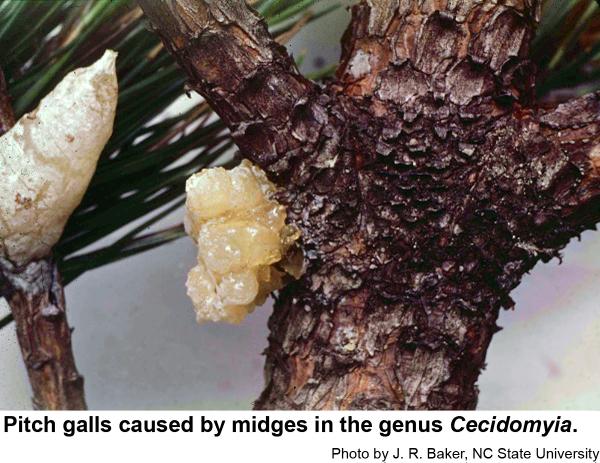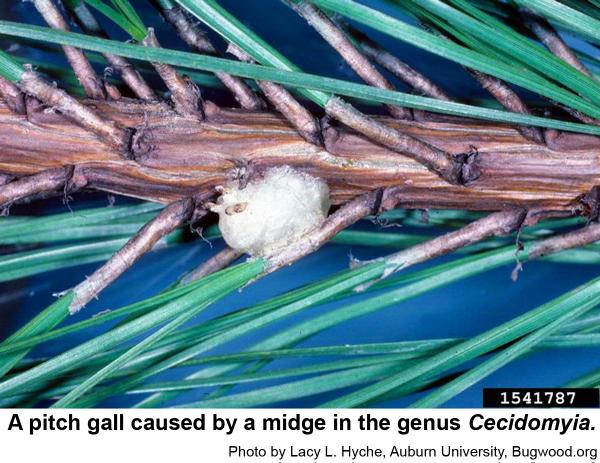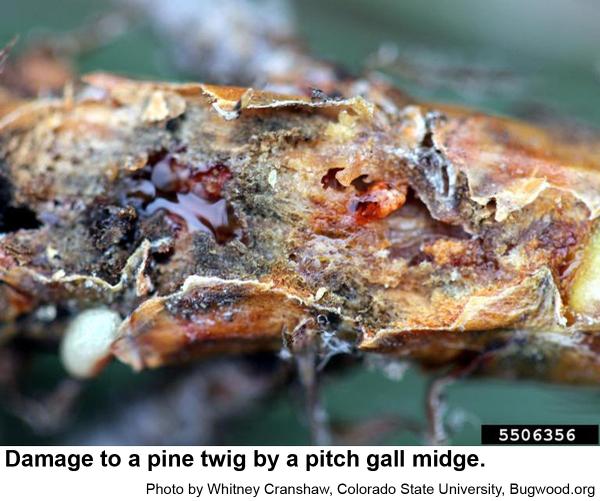Description and Biology
Pitch gall midges or resin gall midges are several species of tiny, mosquito-like, flies in the genus Cecidomyia that lay eggs on the twigs of pines in spring. Tiny maggots hatch and bore into the cambium layer of the twig, which cause pitch to ooze out and form a mass almost 1/2 inch wide. The maggots then develop inside the pitch -- hence the name resin gall midges or pitch gall midges. Fully grown maggots are slender, orange, and 3/16 to 3/8 inch long. They keep their rear spiracles in contact with air. Mature maggots either remain in the pitch masses to pupate or leave depending on the species. Those remaining in the pitch pupate in a silken cylinder. Pupae push through a thin cap to protrude from the pitch gall and adults soon emerge. Those maggots that leave the pitch gall pupate nearby. Pitch galls are most noticeable in early to mid April. Populations of pitch gall midges vary greatly from year to year. This is highly likely that the populations of other resin gall and pitch midges also fluctuate. We have one generation per year in North Carolina.
Host Plants
Almost all species of yellow pines can be infested with pitch gall midges. White pine is infested by a single species, Cecidomyia candidipes, the only species of pitch gall midges that is confined to a single host in North Carolina. Pitch midge galls are relatively common on pines and they can cause minor dieback on loblolly pine. Sometimes pitch galls melt and drip down from infested pines onto cars unfortunately parked beneath.
Residential Recommendations
For best control, a pesticide would have to be directed at the adult stage if a specimen tree, important to the landscape, is small enough to spray. One way to figure out when to spray would be to put some of the pitch galls (with maggots) inside into a clear plastic bag and keep them in the shade outdoors. The maggots will pupate and the flies emerge inside the bag. When the tiny midges are seen crawling about inside the bag, that would be the time to spray with a contact insecticide. A systemic pesticide injected into the soil or trunk might give some control as well.
Other Resources
- A Systematic Analysis of the Pine Pitch Midges, Cecidomyia spp. (Diptera: Cecidomyiidae). Gagné, R. J. 1978. USDA Tech. Bull. No. 1575.
- Gouty Pitch Midge. Eaton, C. B. and J. S. Yuill. 1971 (revised). USDA FS Forest Pest Leaflet 46. 8 pp.
- Resistance of Ponderosa Pine to the Gouty Pitch Midge (Cecidomyia piniinopis). Hoff, R. J. 1988. Research Paper INT-387. 3 pp. USDA FS, Intermountain Research Station.
- Taxonomy of the Genus Cecidomyia (Diptera: Cecidomyiidae) with Special Reference to the Species Occurring on Pinus banksiana Lamb. Vockeroth, J. R. 2012. The Canadian Entomologist 92 (1): 65-79.
- Extension Plant Pathology Publications and Factsheets
- Horticultural Science Publications
- North Carolina Agricultural Chemicals Manual
For assistance with a specific problem, contact your local N.C. Cooperative Extension center.
This Factsheet has not been peer reviewed.
Publication date: April 10, 2019
Reviewed/Revised: Feb. 19, 2024
Recommendations for the use of agricultural chemicals are included in this publication as a convenience to the reader. The use of brand names and any mention or listing of commercial products or services in this publication does not imply endorsement by NC State University or N.C. A&T State University nor discrimination against similar products or services not mentioned. Individuals who use agricultural chemicals are responsible for ensuring that the intended use complies with current regulations and conforms to the product label. Be sure to obtain current information about usage regulations and examine a current product label before applying any chemical. For assistance, contact your local N.C. Cooperative Extension county center.
N.C. Cooperative Extension prohibits discrimination and harassment regardless of age, color, disability, family and marital status, gender identity, national origin, political beliefs, race, religion, sex (including pregnancy), sexual orientation and veteran status.



